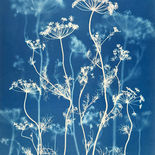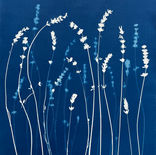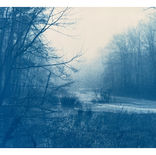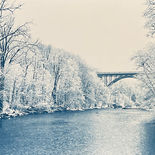Cyanotype
Cyanotype is an alternative photographic process and is one of the oldest photographic printing processes in the history of photography. Light sensitive chemicals are applied to paper, then, items such as plants, objects, digital and analogue film negatives. are placed on the paper. It is then placed under a UV light source. After exposure to, the image is developed with water after which a blue and white image appears. Cyanotype was first introduced by the astronomer, scientist, and botanist John Herschel in 1842 as a way to reproduce his notes and drawings. In 1843, Anna Atkins used cyanotype to create a photographic album in 1843; it was of algae specimens. She made these photograms by laying the algae directly on the photosensitive paper. After a decade, she eventually produced three volumes of her book: 'Photographs of British Algae: Cyanotype Impressions', the first book to be photographically printed and illustrated. Herschel and Atkins were true pioneers in the field of photography.
This is just a sampling of my work. More pieces are available at galleries. Check the home page for show times and dates.
Commissions accepted.
©2022 Bonnie O App. All rights reserved.
Purchase of a copyright artwork does not transfer the copyright. The copyright to produce the works in copies, to produce derivative work based on the copyrighted image, & distribute copies is retained by the Artist.
























